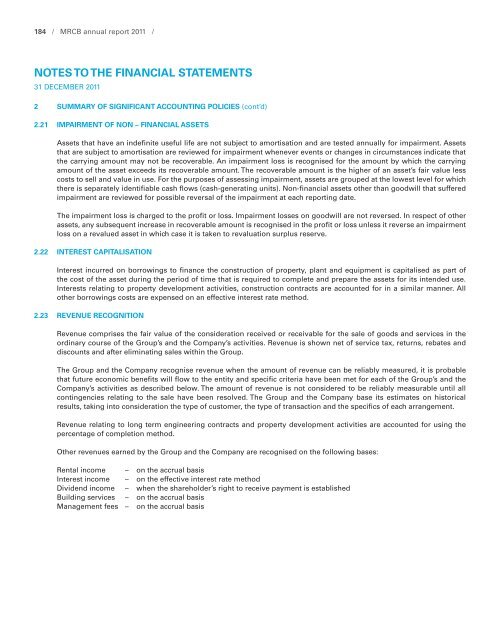Connecting the nation. and Beyond. - ChartNexus
Connecting the nation. and Beyond. - ChartNexus
Connecting the nation. and Beyond. - ChartNexus
You also want an ePaper? Increase the reach of your titles
YUMPU automatically turns print PDFs into web optimized ePapers that Google loves.
184 / MRCB annual report 2011 /<br />
NOTES TO THE FINANCIAL STATEMENTS<br />
31 DECEMBER 2011<br />
2 SUMMARY OF SIGNIFICANT ACCOUNTING POLICIES (cont’d)<br />
2.21 IMPAIRMENT OF NON – FINANCIAL ASSETS<br />
Assets that have an indefinite useful life are not subject to amortisation <strong>and</strong> are tested annually for impairment. Assets<br />
that are subject to amortisation are reviewed for impairment whenever events or changes in circumstances indicate that<br />
<strong>the</strong> carrying amount may not be recoverable. An impairment loss is recognised for <strong>the</strong> amount by which <strong>the</strong> carrying<br />
amount of <strong>the</strong> asset exceeds its recoverable amount. The recoverable amount is <strong>the</strong> higher of an asset’s fair value less<br />
costs to sell <strong>and</strong> value in use. For <strong>the</strong> purposes of assessing impairment, assets are grouped at <strong>the</strong> lowest level for which<br />
<strong>the</strong>re is separately identifiable cash flows (cash-generating units). Non-financial assets o<strong>the</strong>r than goodwill that suffered<br />
impairment are reviewed for possible reversal of <strong>the</strong> impairment at each reporting date.<br />
The impairment loss is charged to <strong>the</strong> profit or loss. Impairment losses on goodwill are not reversed. In respect of o<strong>the</strong>r<br />
assets, any subsequent increase in recoverable amount is recognised in <strong>the</strong> profit or loss unless it reverse an impairment<br />
loss on a revalued asset in which case it is taken to revaluation surplus reserve.<br />
2.22 INTEREST CAPITALISATION<br />
Interest incurred on borrowings to finance <strong>the</strong> construction of property, plant <strong>and</strong> equipment is capitalised as part of<br />
<strong>the</strong> cost of <strong>the</strong> asset during <strong>the</strong> period of time that is required to complete <strong>and</strong> prepare <strong>the</strong> assets for its intended use.<br />
Interests relating to property development activities, construction contracts are accounted for in a similar manner. All<br />
o<strong>the</strong>r borrowings costs are expensed on an effective interest rate method.<br />
2.23 REVENUE RECOGNITION<br />
Revenue comprises <strong>the</strong> fair value of <strong>the</strong> consideration received or receivable for <strong>the</strong> sale of goods <strong>and</strong> services in <strong>the</strong><br />
ordinary course of <strong>the</strong> Group’s <strong>and</strong> <strong>the</strong> Company’s activities. Revenue is shown net of service tax, returns, rebates <strong>and</strong><br />
discounts <strong>and</strong> after eliminating sales within <strong>the</strong> Group.<br />
The Group <strong>and</strong> <strong>the</strong> Company recognise revenue when <strong>the</strong> amount of revenue can be reliably measured, it is probable<br />
that future economic benefits will flow to <strong>the</strong> entity <strong>and</strong> specific criteria have been met for each of <strong>the</strong> Group’s <strong>and</strong> <strong>the</strong><br />
Company’s activities as described below. The amount of revenue is not considered to be reliably measurable until all<br />
contingencies relating to <strong>the</strong> sale have been resolved. The Group <strong>and</strong> <strong>the</strong> Company base its estimates on historical<br />
results, taking into consideration <strong>the</strong> type of customer, <strong>the</strong> type of transaction <strong>and</strong> <strong>the</strong> specifics of each arrangement.<br />
Revenue relating to long term engineering contracts <strong>and</strong> property development activities are accounted for using <strong>the</strong><br />
percentage of completion method.<br />
O<strong>the</strong>r revenues earned by <strong>the</strong> Group <strong>and</strong> <strong>the</strong> Company are recognised on <strong>the</strong> following bases:<br />
Rental income – on <strong>the</strong> accrual basis<br />
Interest income – on <strong>the</strong> effective interest rate method<br />
Dividend income – when <strong>the</strong> shareholder’s right to receive payment is established<br />
Building services – on <strong>the</strong> accrual basis<br />
Management fees – on <strong>the</strong> accrual basis

















